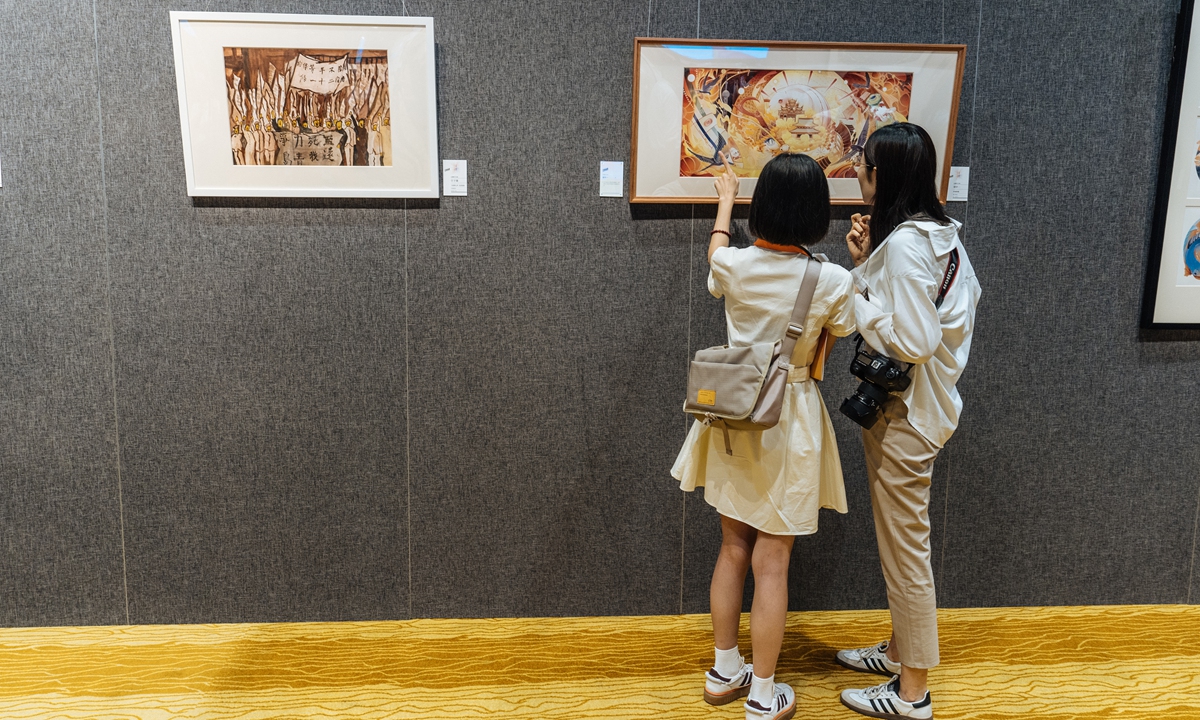
Photo: Li Hao/GT
More than 70 works by young artists from both sides of the Taiwan Straits, including paper cutting, carvings, ceramics, and murals, went on display in Beijing on Tuesday as part of a program through which young people from both the Chinese mainland and the island of Taiwan gained mutual understanding, exchanged artistic insights and jointly inherited traditional Chinese culture.
Showcasing a total of 73 works by 16 young artists from the island and eight from the mainland, the 2024 Art Blossoms - Cross-Straits Young Artists' Exhibition kicked off at the Taiwan Assembly Hall in downtown Beijing on Tuesday.
The event was hosted by the Cultural and Publicity Department of the All-China Federation of Taiwan Compatriots.
"Through getting to know and interacting with each other, young people from both sides can enhance understanding, build mutual trust, resolve doubts, and seek consensus. The cultural exchanges between the two sides of the Taiwan Straits allow us to explore our roots, consciously become protectors, inheritors, and promoters of Chinese culture, and strengthen the sense of belonging, identity, and honor of the Chinese nation," said Bai Tianliang, vice president of the All-China Federation of Taiwan Compatriots, in his opening speech.
At the scene, works that integrated modern art and traditional culture were on display.
Chen Chia-ching, a graduate student from Xiamen University and a representative of the young artists from the island of Taiwan, started learning paper cutting at the age of 8. In this exhibition, she brought her paper cutting works, including one of them depicting a farming scene and another with the theme of blessings for both sides of the Taiwan Straits.
"The theme of farmers was inspired by my grandmother and her farmer friends at work. From my grandmother, I saw the hardworking, simple, and kind qualities that are common among laborers," Chen told the Global Times.
The inspiration for her second work came from Mazu culture and features Mazu's image and waves as the main visuals. Mazu is a goddess worshipped in China, especially in East China's Fujian Province and the island of Taiwan.
"Through this work, I hope to further explore the shared culture on both sides of the Taiwan Straits, inherit traditional Chinese culture and tell the Chinese story well."
Hu Chung-yi, a student from the China Academy of Art and an artist from the island, donated a painting titled Auspicious Blessings at the opening ceremony.
"There are indeed many common cultural and life styles between the two sides, including many similarities in language. Through exchanges, we can deepen mutual understanding and fundamentally recognize our cultural heritage. Exchanges among youths are particularly important and need to be conducted in a more youthful manner. This exhibition is a great event where everyone can gather together for direct and close exchanges, which is rare and precious," she said.
Kuo Yi-hsin, a graduate of the Sichuan Fine Arts Institute, specializes in installation art. She exhibited three works incorporating the many cultural elements of Chongqing Municipality, such as mahjong, hot pot, and lions.
"This exhibition is a great platform, and the organizers have put in a lot of efforts. It is a great opportunity for me," she said.
Professor Ma Lu, former dean of the Plastic Art School at the Central Academy of Fine Arts, told the Global Times that art students from the island are very creative and can study and create independently.
Seeing many artworks displaying Chinese elements, Ma commented, "Since these young artists from the island of Taiwan came to the mainland to study, they must learn about Chinese culture and showcase traditional Chinese elements. Furthermore, traditional Chinese culture is alive; it can provide a lot of new knowledge, new imagination, and new expressive techniques, making it very vibrant."
"Since the 1940s, the entire artistic inclination on the island has been very Westernized. Originally, during the Japanese occupation period, Chinese culture was inherited, including influences from the May Fourth Movement. This was reflected in novels, paintings, literature, and theater. However, after the 1950s, the Westernization trend became more severe, and people gradually overlooked the Chinese history," Chang Li-pen from Huaqiao University, who is also the lead instructor for the artists from the island of Taiwan, told the reporters at the event.
"If we only imitate the West, we cannot develop our own unique style. By integrating our historical and cultural elements into our creations, we can have a broader perspective and greater potential for our art," he noted.



